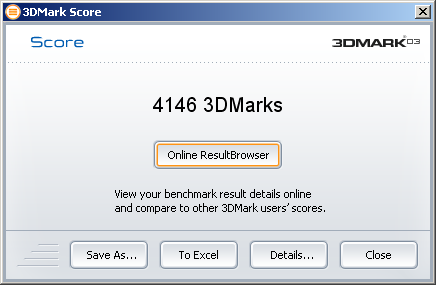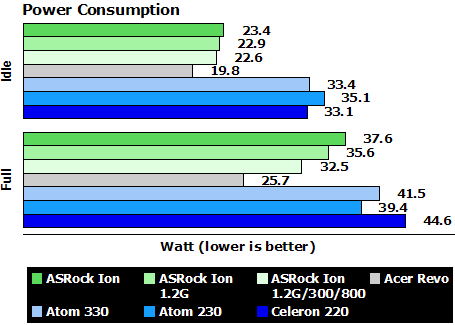Index
Page 6 of 6
We are sorry not to bore you with useless 3DMark numbers, except 2003 which we used for full power consumption. Neither the Ion nor the Atom are designed to give you a gaming experience and we have better things to do than waste time with that. If you happen to use games which were state of the art in 2003 or before, you can play them. As we have shown decoding HD content is the strong suite of the Ion as long as you have a player to do so. We had no problems with XP or Windows 7. Kudos to the Media Player Classic developers which managed to support DXVA for XP and decoding mostly faster as a 64-bit Windows 7.

Power-Consumption was a bit off from what we originally expected, but a dual-core running mostly under 30W in normal operation is not a bad thing. Under load Ion does contribute about 15W. All LEDs, IR and WLAN were disabled to reduce energy consumption as much as possible. Due to the normal board design in contrast to the Revo power-consumption is higher. Downclocking the Ion and the Atom resulted in 5W reduction and a very quiet system.

Conclusion:
The ASRock Ion330HT box is a two edged sword. While we were impressed with the HD support of the Ion and the quite delay-free operation under Windows, we have some issues with the box itself. The 3cm fan is a bad idea, because it's not possible to remove the noise completely, as it has to spin at a considerable speed to generate any airflow. In Europe we like noiseless computers, especially if they don't feature superior performance. A better cooling system is the wish for the next revision of the box. Also to have left out USB 2.0 ports and/or SATA connectors on the front is bad choice.
The box is not a bargain. You can buy it for about €220,- as a barebone, or cash out €80,- more to get it with a DVD burner, 320GB hard drive and 2GB memory. The top model we tested here comes with a Blu-ray reader and DVD burner combo drive for about €395,- which is the best offer, considering the optical drive costs €150,- alone.
Removing the 3cm fan and downclocking the Atom and the Ion made the experience quite nice, but we think ASRock should consider noise before they design a desktop. ASRock did send us a BIOS which can reduce the Ion to 300/800MHz, which should be released in a week or two. The lower speeds are still good for HD-content but will decrease the heat and enables any user to remove the 3cm fan. You can also reduce the speed of the back-fan to ultra-silent and the box gets really quiet.
All in all, we like the box despite these flaws and if you are searching for a second machine to save some energy without the need to run your quad-core/SLI machine all the time, this is the computer for you to do basic stuff and watch HD-content.
« Prev Next
